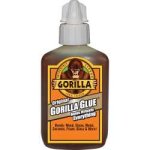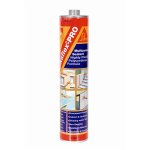Good point. You'll get it on your fingers and you won't get it off. It's the stickiest stuff...
PU glue can be a blessing or a curse. It's excellent for building ie a horn enclosure because it expands and fills gaps, imprecise angles, it is not impressed by moisture after curing and glues almost anything very fast. But it prevents "zero thickness" glue joints too. I like to have a bottle of it at hand but usually the normal wood glue is the better choice.
Wait, I'm not talking about polyurethane glue as used for woodworking.
Not..

I'm talking about this..

I can't remember the type but Bunnings have two I can think of. The one shown here is softer, I'd try to get the other first but this will work. It's easy to test, just use two scrap pieces of MDF and after it sets, tilt it and drop a hammer on it.
Not..

I'm talking about this..

I can't remember the type but Bunnings have two I can think of. The one shown here is softer, I'd try to get the other first but this will work. It's easy to test, just use two scrap pieces of MDF and after it sets, tilt it and drop a hammer on it.
What exactly do you mean with lining? As in glueing some panels to the steel (profiled?) walls? That will do something but isn't nearly as effective as a sandwich construction with a layer of air (some 2" or thicker) between the steel and the inner panels. Especially since the sound source is mid frequencies I would not abandon that idea too quick.the discussion turned to first lining this steel shed
Mind you, in terms of perception a difference of 6dB isn't really that much. I'd aim for 12 to 18dB(A) noise reduction and that is doable with a flexible front wall (over here we call it a 'buigslappe voorzetwand').
The shed is a steel portal frame, steel cladding over steel top-hat battens, so the ling would be glued to the inside of the top-hat with a 55mm airgap between plaster sheet and the steel cladding.
Long term project and it might take a year or more to come to fruition
Long term project and it might take a year or more to come to fruition
In my youth I worked in carpentry specialises in isolated walls and doors. For the walls we applied a sandwich composed by 6mm bituminous panel, a 10mm layer of woodfiber panel, a 25mm rockwool panel and then a 19mm plywood/mdf/osb panel.
The door sandwich was composed by 40mm wood panel, the same isolation layers as above, and another 19mm wood panel.
The isolation layers were included in a wood/felt frame pressing against the sides of the door frame.
Attenuation was about 40 db when using the 3-layer sandwich.
The door sandwich was composed by 40mm wood panel, the same isolation layers as above, and another 19mm wood panel.
The isolation layers were included in a wood/felt frame pressing against the sides of the door frame.
Attenuation was about 40 db when using the 3-layer sandwich.
40dB is massive. Luckily I don't think we need as much as that.
My mate and I have very similar sheds. The big difference between them is my use of Kingspan Aircell insulation.
It's only 5mm thick but I do notice that my shed is less noisy than his when playing music to similar volumes. Unfortunately retro fitting the foam insulation is an almost impossible task. I'm in the process of lining my own shed with the SwissKrono low density chipboard and that seems to be making a big difference. I managed to get a small number of panels cheap as end of line and damaged and I've been doing the walls slowly
My mate and I have very similar sheds. The big difference between them is my use of Kingspan Aircell insulation.
It's only 5mm thick but I do notice that my shed is less noisy than his when playing music to similar volumes. Unfortunately retro fitting the foam insulation is an almost impossible task. I'm in the process of lining my own shed with the SwissKrono low density chipboard and that seems to be making a big difference. I managed to get a small number of panels cheap as end of line and damaged and I've been doing the walls slowly
40dB is massive. Luckily I don't think we need as much as that.
My mate and I have very similar sheds.
Sheets? Sorry for the bad pun. No, I don't disaproove of that.
The big difference between them is my use of Kingspan Aircell insulation.
It's only 5mm thick but I do notice that my shed is less noisy than his when playing music to similar volumes. Unfortunately retro fitting the foam insulation is an almost impossible task. I'm in the process of lining my own shed with the SwissKrono low density chipboard and that seems to be making a big difference. I managed to get a small number of panels cheap as end of line and damaged and I've been doing the walls slowly
The properties of the product you're using determines if it's perfect or just unusuable. If you can use it for one situation doesn't mean you can use it in a different situation at all. Unless the circumsances are described more precisely, no suggestion can be made since it's just guessing.
Just guessing is fine in a theoretical discussion about possibilities. Perfection isn't needed; just adequate is fine.
I have emailed Kingspan asking if they have any data on acoustic properties but I doubt they have ever done any testing of that; but getting back to the original post "Anything is better than nothing" even if it is only a 3dB cut it all adds up
I have emailed Kingspan asking if they have any data on acoustic properties but I doubt they have ever done any testing of that; but getting back to the original post "Anything is better than nothing" even if it is only a 3dB cut it all adds up
In acoustics, 3dB can be massive or barely noticable. Anyway, without knowing the context, you can't say anything about if it meets the requirements, so it's moot to discuss that anyway.
I think that will do well. Fill the air gap with mineral wool of 20kg per cubic meter. Apply some kind of moist barrier on the inside of the cladding so that your steel won’t oxidize in no time due to condensation on the inside. Could be a foil, could be a cladding with built-in barrier. Close every hole, gap or slit in that barrier with tape, glue or pu foam.The shed is a steel portal frame, steel cladding over steel top-hat battens, so the ling would be glued to the inside of the top-hat with a 55mm airgap between plaster sheet and the steel cladding.
Long term project and it might take a year or more to come to fruition
- Home
- General Interest
- Room Acoustics & Mods
- Design help request from a mate